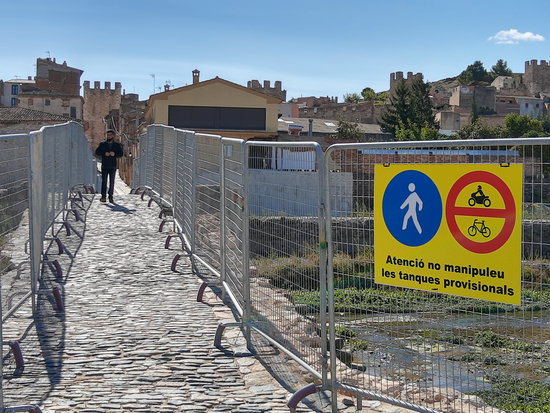Hit by flash floods a year ago, some Catalan towns are still recovering
Heavy rains caused rivers such as the Francolí to burst their banks and produce extreme damage, especially in Western Catalonia

A year ago on October 22, 2019, heavy rains swept through Catalonia, hitting some Western counties the hardest, causing flash floods. Five people died and the whereabouts of two more remain unknown.
There were also severe disturbances to daily life as several trains were suspended and 46 roads, mostly local, were put out of action. In l’Espluga de Francolí, one of the most severely affected towns in the Conca de Barberà county, fallen trees blocked off roads around the town.
It has now been a year since this natural disaster. Sobering displays of remembrance for the catastrophe are taking place on the anniversary in Montblanc and l’Espluga.
Lasting effects
However, some of the scars remain. Josep Andreu, the mayor of Montblanc, the capital of Conca de Barberà county, told ACN that “one year on and we still do not have the financial aid we were promised the day after the flood.” Although the decree was approved two months ago by the Spanish government the agreements for this are still not signed, delaying aid for various councils.
L’Albi and l’Arbeca, villages situated in the Lleida and Lerida province respectively, are facing similar problems, with both being forced to take money from the coffers to repair some of the damages.
Many of the sports facilities in l’Albi, such as the municipal swimming pools and the athletics tracks, are now unusable. Anna Feliu, l’Albi’s mayor has said that in small towns, losing this sort of facilities will cause “depopulation”.
Montblanc has lost millions of euros, and their bridge will remain covered in railings until 2021. In the same town, a block of flats near the river there has also been inhabitable since the disaster and despite campaigning from the neighborhood, they still await a response.
In l’Espluga, the river destroyed many of the town’s orchards and Pep Andreu, the mayor, explained to ACN that “without direct help we will not be able to rebuild them.”
A flood of solidarity
In l’Espluga the ruins of the Rendé Masdéu wine cellars continue to be visible.
The Masdéu cellars, like many others, received the help of La Riuda Solidaria (the Flood of Solidarity), an association set up three days after the river burst its banks. The group aimed to raise money for the victims of the natural disaster.
Now installed in an old closed down restaurant, the owner of Rendé Masdéu, Mariona Rendé, have been able to start over. Despite what happened, their new premises remain close to the river, wanting to stay in touch with their origins.
The cellars will be showing pictures and projections from their ‘mud wine’ project, in which they recuperated the wine bottles from the river.
After more than a 100 charity activities the Flood of Solidarity had raised 150,000 euros. In July they were able to disband. They distributed the money between 60 projects.
One of these was Drac Actiu, a provider of outdoor activities. With the help of the charity, they were able to rebuild an office.
Drac Actiu’s insurance only covers a fifth of their reconstruction costs. Despite investing all their money into repairs, Gonzalo Gil, head of the company lamented that, with the effects of the coronavirus, the business is seeing a “second flood.”
Hope for the future
However, not all was lost and some of the affected areas have been rebuilt and repaired.
For example, it was confirmed this September that all sewage and sanitation systems had been restored in l’Espluga and Vimbodí, whilst that of Montblanc had been restored in May. The sanitation system in l’Espluga had been particularly badly affected as a 1km section of the sewage collector had disappeared.
Various Catalan scientists have also studied the river in the year following the deluge. They are hoping to come up with conclusions that will help avoid this sort of disaster from reoccurring.
Jordi Pujada, a geologist from Montblanc, has suggested that this tragedy might have come from a bridge falling and breaking into the body of water.
GAMA, the department of applied physics at the University of Barcelona, has focused on studying the human effects and how to minimize them.
The group has noticed that since 1994 in l’Espluga there have been 15 inundations. Maria del Carme Llasat, the group´s coordinator, concluded that “they have had and will continue to have them; it is a case of co-existing with the river in the way that causes the least damage.”